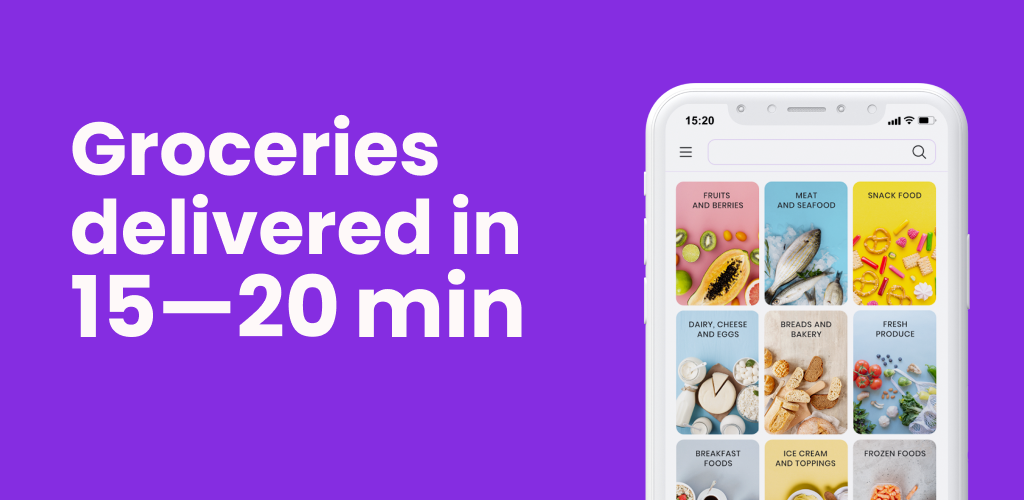Building 1520: A Fast-Paced Flutter Food Delivery App
🚀 1520: Building a Food Delivery App Under Pressure

In 2020, the rapid expansion of on-demand food delivery created a competitive race in major cities. 1520 was our startup’s attempt to enter this market before major players like Getir arrived in New York City.
As the sole Flutter developer, I was responsible for building a fully functional food delivery app from scratch within a strict timeframe. This meant balancing speed, performance, and usability, all while overcoming technical challenges like Stripe integration, polygonal geofencing, and complex UI interactions.
📌 The Challenge: Shipping an MVP in 2 Months
The goal was ambitious:
- Develop a standalone food delivery app (not just an aggregator).
- Provide a seamless user journey from ordering to delivery.
- Implement a location-based warehouse detection system for optimized logistics.
- Integrate Firebase for backend connectivity to move fast.
- Support web & desktop versions for a wider reach.
- Build and launch within 2 months to stay ahead of the competition.
🛠 The Tech Stack: Flutter + Firebase
To maximize development speed, we chose Flutter for its cross-platform support and fast UI iteration.
- Frontend: Flutter
- Backend: Firebase (Firestore, Authentication, Messaging, Crashlytics, Analytics)
- Payments: Stripe (multiple plugin solutions)
- Geolocation & Mapping: Custom polygonal geofencing system
- Web/Desktop: Flutter Web
Firebase enabled agile backend development without needing a dedicated backend team, allowing me to focus on building the app experience.
💡 Solving Key Engineering Challenges
1️⃣ Stripe Integration in Flutter (2020)
Back in 2020, Stripe support for Flutter was far from perfect. I had to combine two of the most popular Stripe plugins and pick the best features from both to achieve a reliable payment flow.
Solution:
- Researched Flutter Stripe plugin alternatives.
- Integrated and tested multiple approaches.
- Merged the most stable features from two libraries.
2️⃣ Scroll Synchronization for Category Navigation
One of the hardest UI challenges was syncing a vertically scrollable product list with a horizontally scrolling category selector—something no existing Flutter library handled well.
Solution:
- Used two scroll controllers to track user interactions.
- Listened for scroll events and adjusted animations accordingly.
- Ensured smooth performance while maintaining pixel-perfect UI.
3️⃣ Optimized Warehouse & Delivery Area Detection
Since 1520 operated using local micro-warehouses, it was critical to ensure that users were matched with the nearest warehouse while staying within a defined coverage area.
To achieve this, I developed a custom geolocation-based address input and location picker with polygonal geofencing. The goal was to determine whether a user’s selected location fell within a delivery zone polygon.
Solution:
- Implemented an address input field with location auto-completion.
- Developed an interactive location picker, allowing users to manually adjust their pin.
- Used a point-in-polygon (PIP) algorithm to determine whether the selected pin was inside a warehouse coverage zone.
- Used Google Maps webservices for auto-completion and validation.
💡 This approach ensured precise warehouse assignment, reducing delivery errors and optimizing logistics.
4️⃣ Adapting the App for Web & Desktop
While Flutter Web was still maturing in 2020, I adapted the app to work on tablets, desktops, and browsers. This required fixing multiple plugin compatibility issues and implementing a responsive UI.
Solution:
- Used Flutter Web directly for rapid adaptation.
- Debugged and patched multiple plugins that weren’t web-compatible.
- Designed responsive layouts for desktop & mobile.
🎯 The Outcome: Launch, Growth & Acquisition
The MVP was completed in just 2 months, with continuous improvements over the next 2 months while the business team prepared warehouse logistics and delivery operations.
After launch, 1520 operated successfully in NYC for a full year, gaining traction in a hyper-competitive market before eventually being acquired by Getir.
In 2021, I continued to support and maintain the app, including direct hotfixes to product data on the server, ensuring smooth operations post-launch.
🔥 Lessons Learned
- Speed is key in startups, but technical debt must be balanced wisely.
- Some technically difficult problems (like scroll sync) may not be necessary for MVP. Knowing when to cut complexity is crucial.
- Geolocation & delivery logic are just as critical as UX. The polygonal geofencing system significantly reduced failed deliveries.
- Product ownership goes beyond coding. I had to make decisions fast, solve problems beyond development, and take full responsibility for the product’s success.
🌟 Final Thoughts
Building 1520 was an intense but rewarding experience. It pushed my Flutter skills, refined my product vision, and gave me a firsthand look at the challenges of fast-growing startups.
If you’re building a high-speed MVP in Flutter, my advice is:
✅ Choose the simplest backend solution (Firebase worked great).
✅ Be flexible with UI challenges—some aren’t worth the effort.
✅ Keep an open mindset—things will break, but quick iterations win.
✅ Geofencing matters in delivery apps—a smart point-in-polygon algorithm makes all the difference.
Fifteentwenty — 1520 - Key facts
Would love to hear your thoughts—have you built a fast-paced startup app? 🚀 Drop a comment below!

Comments